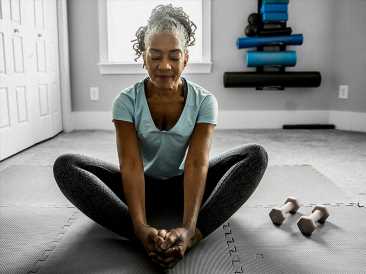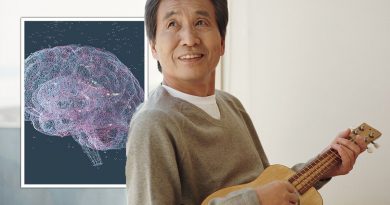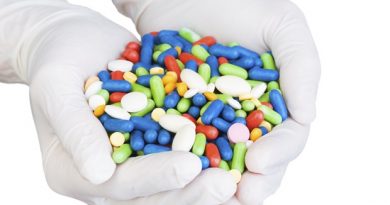An exercise ‘sweet’ spot may reverse cognitive decline

- A recent study has discovered an exercise “sweet spot” that reverses cognitive decline in aging mice.
- The research team discovered that 35 days of continuous exercise improved learning and memory deficits in the aging animals.
- Their findings also suggest an explanation for how and why exercise improves cognitive function.
Various studies show that exercise provides the body with multiple potential health benefits.
From immediate improvements, such as more efficient metabolism, to long-term gains, such as protection against cancer, the benefits are abundant.
Recently, these benefits have come to include the health of the brain — particularly the hippocampus, which is responsible for learning, emotions, and memory formation.
For a long time, scientists have been unsure of how and why exercise improves brain function.
Now, a new study by researchers at the Queensland Brain Institute (QBI) at the University of Queensland, Australia, has set out to explain this phenomenon.
The research suggests that optimal levels of exercise lead to an increase in circulating growth hormone (GH), resulting in an improvement in cognitive functions.
GH, a protein that the pituitary gland makes, helps control growth and the use of glucose and fat in the body.
“The work we conducted identifies some key mechanisms as to how and why exercise induces [cognitive] changes,” says co-lead author and research fellow Daniel Blackmore, Ph.D.
The conclusions from the new research appear in two separate papers in the journal iScience — the first published in October 2021 and the second in November.
A tale of two experiments
In this study, Dr. Blackmore and his colleagues conducted two experiments.
First, they investigated whether an increase in GH levels correlated with exercise points at which aged mice showed significant cognitive improvements.
Then, they looked at whether GH played a causal role in the timing and activation of the exercise-related benefits that they observed in the animals.
During the experiments, the scientists used various behavioral tests to assess the animals’ cognitive functions, noting the corresponding results.
In addition to behavioral tests, the experimenters harvested blood samples from the animals, alongside tissue samples from the brain and the pituitary gland. These samples allowed them to observe exercise-induced changes in the hippocampus and to monitor changes in GH levels.
The researchers compared all test results against a control group.
35 is the ‘magic number’
At first, the scientists observed that the older mice performed significantly less well than their younger counterparts in the behavioral tests.
Following this round of tests, the team housed the animals in a cage and gave them access to a running wheel.
On repeating the behavioral tests, the scientists found that older animals that ran for 35 days showed learning improvements similar to those of non-running young animals.
Surprisingly, they discovered that exercise periods longer or shorter than 35 days had no noticeable effects on learning. Due to this, they called the 35-day mark an exercise “sweet spot.”
To confirm the importance of this sweet spot, the scientists tested another set of animals using a different behavioral test. They observed similar learning improvements in the new set of aged mice that ran for 35 days.
After this observation, the researchers turned to GH levels to understand why a precise period of exercise improved cognitive functions. Here, they noticed that circulating GH levels peaked during the exercise sweet spot.
In addition, the team discovered that GH stimulates the production of new neurons in the hippocampus.
This led the scientists to conclude that GH plays a central role in the cognitive benefits observable from exercise in aged mice.
In the second study, they investigated how the production of new neurons changed the circuitry in the aged murine brain.
Using a noninvasive MRI procedure, the team discovered that improved spatial learning was a result of enhanced connectivity in the dentate gyrus, part of the gateway to the hippocampus.
“This study showed for the first time that exercise can restore connectivity within the mouse brain,” Dr. Blackmore told Medical News Today, noting that the study “identified which regions [in the brain] are essential for successful spatial learning.”
Managing expectations
To understand the implication of the results, MNT sought an expert opinion.
Dr. Jennifer Bramen, Ph.D., a senior research scientist at the Pacific Neuroscience Institute, Santa Monica, CA, explained that any intervention that shows neurogenesis — the growth of new neurons — in the adult brain is “highly exciting.”
She also added that the “results from the study are highly valuable.”
However, she encouraged the public to adopt a mindset of patient optimism:
“The clinical implication of this and the growing body of research on aerobic exercise is that it is an incredibly valuable tool for preserving brain health and cognitive abilities as we age.”
“One of their key findings,” Dr. Bramen added, “is that it takes time (35 days) for mice to experience significant improvement in their cognition.”
“It is important to manage expectations regarding how quickly a person will experience a significant benefit from regular aerobic exercise. [However], it is [also] important to continue to exercise to maintain these benefits,” she concluded.
An ‘optimal’ exercise paradigm
As Dr. Bramen noted, the results from the study are valuable. However, the study is not without limitations.
First, the team used only healthy aged female mice in their work. Therefore, the experiments need repeating in male mice to determine whether the findings apply to both sexes.
This is necessary because the exact timing to experience the benefits of physical exercise may differ between the sexes.
Furthermore, there is still a need for human studies to confirm the scientists’ findings.
The team plans to study this in the future. In a conversation with MNT, Dr. Blackmore revealed that as a result of the GH biomarker, scientists can now identify when exercise has reached an optimal level that aids brain function.
Additionally, he said, because of the noninvasive approach that the researchers used in the experiments, he is confident that “similar approaches can be undertaken with human subjects.”
“Our ultimate goal is to identify an optimal exercise paradigm that can improve human cognition in aged people to slow down the rate, delay, or even prevent dementia. These animal studies pave the way for this work.”
– Dr. Blackmore
Source: Read Full Article



